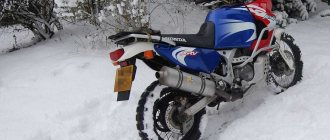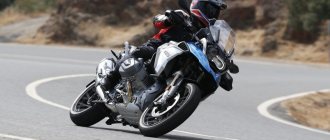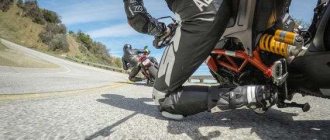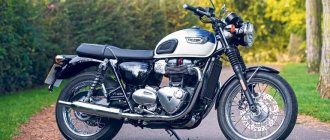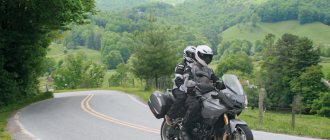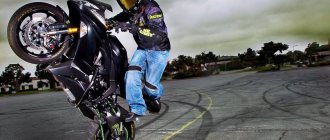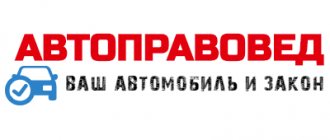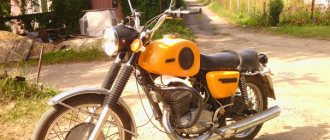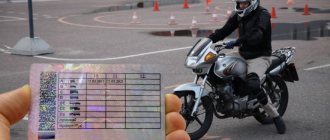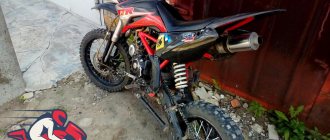Learning to ride a motorcycle is easier than you think! Many people wonder, is it necessary to start at all? Sounds strange, doesn't it? Riding a motorcycle is dangerous, it’s cold and sometimes wet, you can’t really ride it in winter, but you still have to pay taxes. This is not Africa after all. Falling on a motorcycle, falling on its side, or being unnoticed by a truck driver is a piece of cake. And how much money! One decent piece of equipment will cost the same as a used Renault Logan. Maybe, hey, this motorcycle, maybe it’s worth saving up and buying a normal crossover... If you really think so, you don’t have to read any further. Because those who once sit on the saddle of a bike never get off again! So have I, ever since my dad took me to a motocross school near home. And away we go – competitions, championships, from dirt to asphalt, but you can read more about this in my Blog – we’re not talking about that now.
A simple tutorial to help you ride a motorcycle.
Dear friend, are you going to learn how to ride a motorcycle? Right? This is probably why you went to a driving school, to gain initial skills in driving a motorcycle and at the same time learn the rules of the road, in order to subsequently obtain a driver’s license of category “A” or “A1”? But for some reason, do you also need additional knowledge, as well as accessible, simple explanations that will help you quickly and easily learn to ride a motorcycle? No problem. Our online publication offers you a small guide - “Step by step” with the help of which anyone can understand for themselves what they need to do in order to quickly learn how to operate a motorcycle.
A motorcycle, like a car, definitely attracts attention. Many of us would like to master it (its control) in our dreams, but as usual, we mistakenly believe in advance that driving a motorcycle is quite difficult and very dangerous. But this, my friends, is not at all like that, in fact, everything is quite simple, you just need to follow all precautions and, of course, the traffic rules, then the motorcycle itself will become no more dangerous for you than a car.
But still, a motorcycle is still considered a high-risk vehicle that can easily get into an accident. Despite this, dear friends, for our part, we believe that our advice will still help you make the process of your initial learning to ride a motorcycle and gaining initial experience more pleasant and comfortable.
EXERCISE “SCOOTER”
To practice this simple technique, you need to find a flat, or almost flat, area with a slight slope. The task is to roll downhill without starting the engine while sitting in the saddle of the bike. In this case, you need to feel the center of gravity of the motorcycle with your weight and transfer your weight, as an experiment, to the right and left.
On the same platform, try to jump on the motorcycle while moving from the left side, as expected. This can be useful, for example, when the battery or starter and kick starter died at the same time. This happens extremely rarely, but you need to be prepared for anything. Continue to frolic in this way until you feel complete control over the physics of the device, its center of gravity and critical angles of deviation from the vertical. Now we come to the most basic part. This includes starting the engine, starting and shifting gears, braking and maneuvering, gas dosage and operating the clutch lever.
Punishment for illegally driving a motorcycle
Russian legislation provides for penalties for driving a vehicle without the appropriate document:
- For driving a vehicle by a driver who does not have a license or documents with him, punishment is provided in the form of a warning or a fine of 500 rubles.
- For driving without a driving license (if the “rider”, in principle, does not have a license) a fine of from 5,000 to 15,000 rubles is provided.
Based on the above points, we can conclude that it is not worth getting caught by traffic police with such violations.
In case of arrest, it is much more cost-effective to convince the traffic police officer that the necessary documents were left at home or in the garage, honestly repent and promise that this will not happen again. In this case, an adequate inspector will limit himself to a fine or even let the rider go unpunished. Oddly enough, but this also happens.
LET'S ALL TOUCH
You need to be able to get going correctly, which is what we will do now. To begin with, recall in your memory the design of your motorcycle’s gearbox and clutch design. This will make it clearer what is happening to the engine when you change gears and squeeze the clutch. When you visually imagine the operation of all components, you will automatically try not to harm them - not to scatter the gearbox gears and not to burn the clutch discs.
Well, the engine is warmed up and idling, you took the bike off the stand and sat comfortably, resting your left foot on the asphalt. Now play with the throttle, synchronize by ear the number of revolutions and the angle of deflection of the throttle from zero. When starting off, the most important thing is to successfully dose the fuel supply, without too much or too little. Otherwise, the engine will either stall when starting off, or the motorcycle will jerk sharply, the consequences of which can be the most unpredictable. Therefore, it is important to know by ear the number of revolutions just necessary to take off, even without the help of a tachometer, if you have one.
If someone ever tells you that they know how to drive a motorcycle, don’t believe them. You can endlessly learn how to control a bike...
Now disengage the clutch by pressing the lever all the way and put it in first gear. Smoothly release the clutch until you feel the engine speed begin to drop and the motorcycle slowly move away. Enough for now. Squeeze the clutch and turn off the gear, put it in neutral and do this exercise until the neutral gear is engaged at the automatic level. This is very important and will save you from hassle at traffic lights and during stops.
When you feel confident (as you think), you can try to really get going. Disengage the clutch, engage first, releasing the clutch simultaneously remove your foot from the asphalt. That's it, you're off. Don’t rush to shift further just yet, ride in first gear, stop several times and start again. Monitor the center of gravity and engine speed when stopping and starting. Everything should work out on a reflex level, you need patience and diligence.
LET'S START THE ENGINE!
Let's imagine that the technical condition of the motorcycle is in perfect order. We have half a tank of gasoline or working mixture, the ignition and power system are working properly. Two-stroke motorcycles are usually started with a kick starter, while four-stroke motorcycles are started with an electric starter. Also, a modern motorcycle will not let you start the engine until you turn off the gear. The neutral gear lamp will indicate this on the instrument panel.
To start a two-stroke engine, just open the fuel line filter tap, open the gas handle a quarter turn, turn on the ignition and pull the kick starter lever. If everything is adjusted correctly, the motor will immediately come to life. The four-stroke engine is started using an electric starter and the carburetor or fuel injection system will already operate the starting system, so there is no need to open the throttle. We start the engine and warm it up to the minimum operating temperature, depending on the motorcycle model and the type of cooling system.
Moto accident
Friends, I don’t like long posts, but in this case it doesn’t work out any other way. I won’t hide that I was inspired to write this post by the wave raised recently by comrade popuren1974. However, I will not fantasize about the future. I will not try to change motorists and our state. And I won’t even touch on the moral side of the matter. I’ll just try to summarize in one post everything that can increase the likelihood of a motorcyclist’s long-term, accident-free enjoyment of the road. Here and now. And I invite everyone to start with themselves.
This post is intended primarily for beginners, the number of which is growing like an avalanche. However, I believe that experienced motorcyclists will be able to find something new for themselves.
In this post I will cover the following topics:
- The art of driving a motorcycle: everything that can help you get out of an unpleasant situation with honor
- Road strategy: motorcyclist safety techniques on the road that minimize the likelihood of getting into a dangerous situation
- Visibility: reducing the likelihood of an accident due to the human factor
- Protection: we minimize losses if the previous points did not help
The Art of Motorcycle Control
You left the traffic police, in your pocket you have a treasured card with an open category, and you think that you know how to drive a motorcycle.
You are wrong! That’s why it’s art, because you can and should learn it all your life. Go to a motorcycle school. Not the one that teaches you how to get your license, but a normal motorcycle school. There you will learn what counter-steering is, how to control a heavy motorcycle at low speeds, how to perform emergency braking, and much, much more. By the way, going to a motorcycle school at the beginning of the season is recommended for everyone who has not ridden in winter. Just to brush up on your skills.
Take up MotoGymkhana, figure driving on asphalt, mainly at low speeds. Do you want to be able to do this?
At least in Moscow, St. Petersburg and Kyiv there are groups that you can join completely free of charge. In addition, nothing prevents you from doing this yourself in any empty parking lot. You can read the report on the high-speed MotoGymkhana here, for example. And searching for VKontakte groups will help you find like-minded people
Go to the track. Yes, it is expensive, but they will teach you how to drive fast with the same degree of risk. Which also means less risk when you drive slowly. How many accidents would not happen if all motorcyclists knew how to place their motorcycle DEEPLY in a turn, while working correctly with the gas, brakes and their body...
In understanding the physics of the process and how to cope with it, 2 books will greatly help you:
- Keith Code: “Motorcycle Driving Techniques” (hint: there is a film based on this book on the root tracker). The book focuses on driving a sportbike on a track.
- Lee Parks: “Full Control” The book is a refraction of the Keith Code technique and largely tells how to train all this and apply it in real life
Take up motocross. Yes, this is also expensive and you will most likely have to rent a motorcycle. Moreover, the off-road driving technique is significantly different from driving on asphalt, especially the cornering technique. But motocross teaches a delicate feel for a motorcycle. Situations that rarely happen on the road and very often cause an accident (skidding, obstacles, etc.) are commonplace here. It’s not surprising that people with cross-country experience get into accidents the least often (there are such statistics)
Exercise whenever possible. Every turn, every bump and every parking lot can become a training exercise for you. Train extreme braking. Practice avoiding and overcoming obstacles. Practice getting out of a skid (if the class of the motorcycle allows you). Exercise whenever possible. Theoretical knowledge of how to behave, not fixed by reflex, will not help you in an extreme situation. And for a stable consolidation of the reflex, even such a highly developed organism as a person requires at least a hundred repetitions.
Features of choosing a motorcycle: Modern motorcycles are equipped with ABS, traction control, different injection maps for different surfaces, integrated braking systems, and other assistants. Feel free to use them! Perhaps they only interfere with professional racers, but most of us are not professionals, right?
Road strategy
You confidently control your motorcycle off public roads.
But how to behave on the road? Automotive experience certainly helps a lot - it gives you the ability to scan your surroundings, unconsciously mark signs, predict the maneuvers of others... In other words, it leaves you more attention to actually driving the motorcycle. However, a motorcycle is a single-track vehicle. This is his strength and this is his weakness. There are a number of dangers that you just need to be aware of and base your behavior on the road on this basis. For example, you don’t need to follow the markings - they are slippery. Rails and curbs should be crossed at as right an angle as possible. There is no need to drive behind a truck (not only can you not see the situation ahead, but their tires also burst much more often than we would like).
These and many other facts are described in David Huff’s book, which is called: “Road Strategy.” Essentially, the book is an analysis of classic accidents involving motorcyclists.
Visibility
The vast majority of accidents involving motorcycles and cars occur because the motorist simply does not see the motorcycle.
The correct road strategy implies that you will not be in the car's blind spot, and that the motorist will have a fundamental opportunity to see/hear you. How can I help a motorist with this? There are actually only 2 options: a bright, preferably flashing picture, and a loud sound, identified as “a motorcycle is riding.” At the same time, it is necessary to increase the visibility of both your own (equipment) and the motorcycle. A separate story is giving an emergency signal in case of danger (horn).
And I repeat, in this post I don’t want to discuss how cool a chopper driver looks in bright yellow gear or how much forward flow infuriates others. To each, as they say, his own. For now, let's focus on how to increase your visibility.
3.1 Conspicuous equipment.
Obviously, the most noticeable equipment is in acid colors with reflective stripes.
Many manufacturers produce special HiViz versions of their equipment. HiViz helmet
HiViz jacket
HiViz suit
In addition, there are many opportunities to temporarily increase your visibility.
HiViz vest
HiViz Backpack (combined with vest)
3.2 Notable motorcycle:
A noticeable motorcycle is not only a bright coloring (ideally with reflective stripes).
This is also forward flow
And the backlight, which is a great help to see you at night, especially if it blinks or changes colors:
Bikepost motorcycle SlidE
And stroboscopes, which are formally prohibited, but there are ways to make headlights work in this mode: The system is implemented on the basis of the domestic development Mayak 2N
3.3 Visibility in an emergency
A typical emergency situation: the motorist did not notice you and began to block the trajectory. You don't have time to slow down. You can't go around. In such a situation, the only thing you can do is notify yourself in every possible way and pray that the motorist stops performing the maneuver.
The manufacturer provides a horn for this situation. However, there are more effective things. For example Banshee Horn
This system consists of a LOUD pneumatic horn and a control controller. The controller connects to the standard signal, the new “snail”, headlights, and the signal button. Now the motorcyclist has 2 options:
- When pressed briefly (1/4 or 1/2 second), the standard signal is triggered. The function is used normally
- When you hold the button for more than 1/2 second, the motorcycle begins to blink with high beams and instead of the standard signal, the pneumatic signal turns on. When it smells fried, you won't go unnoticed
Protection
It is well known that motorcyclists are divided into those who have already fallen and those who have not YET fallen. Obviously, in a head-on collision with a bus at a speed of 200 km/h, no equipment will save you. However, in borderline situations it can significantly reduce damage down to zero. The same applies to protecting the motorcycle itself.
4.1 Equipment set
When choosing a set of equipment, everyone determines for themselves the compromise between protection and convenience.
But first we need to decide what we are protecting ourselves from. This guy may not have correctly identified the likely enemy: Equipment protects us from two dangers: from blows and from “slipping.” Impact protection elements are not designed to protect against any prolonged slipping. Therefore, it is very important to place impact protection elements UNDER the outer layer of abrasion-resistant material (for example, it is more correct to wear knee pads under the leg, and not on top)
In general, there are 2 schools of equipment: off-road (protects well from impacts, practically not from slipping), and “track” (in general, designed for a fall from a height of 1 meter and a long slide). Your set of equipment should protect you from both and from another in sufficient measure. The measure of “adequacy” depends on where and how you drive.
However, in any case, the standard equipment includes protection:
- Heads (helmet)
- Palms (gloves)
- Elbows / shoulders / back (jacket with built-in protection, or jacket + turtle, or separate protection components + jacket)
- Legs (pants with built-in protection, or separate pants and knee pads)
- Motorcycle boots
In addition, many additionally use:
- protection of the hips and tailbone (built into pants, or separate “armored pants”)
- chest protection (inserts in the jacket or turtle)
- Neck protection (special “collar”)
When choosing equipment, pay attention to certificates of conformity.
Helmet 2 certificates are important to us: DOT (American) and ECE 22.05 (European). In general, the European standard is stricter. If the helmet is certified according to both standards, you can be sure that it will not let you down in a real situation. However, it should be remembered that different types of helmets provide different degrees of protection. This is taken advantage of by unscrupulous manufacturers (for example, the Chinese), who often certify integrals according to softer standards of open helmets. The same loophole is often used when certifying: Flip Up helmets and transformable helmets
Other body protection Everything is simple here. If you see the inscription CE, and it corresponds to reality, you can take it. However, it should be noted that back protection has 2 levels of certification: CE Level 1 and CE Level 2. The second type is preferable.
4.1 Motorcycle protection
The motorcycle can also be protected from the possible consequences of falls.
Imagine that the motorcycle fell. What parts does it touch the asphalt? Most likely it is the steering wheel, engine, and axles. They are usually the ones that are protected first. To protect the steering wheel, special weights aka sliders are usually used. However, full-fledged hand protection will not look out of place on enduro and motard bikes:
To protect the engine, either sliders are usually used:
Either arcs/cells:
Pendulums are also often protected with sliders
You can read more about protecting your motorcycle in this post.
Thank you for attention. Get pleasure from your motorcycle, not problems!
Tips for a beginner motorcyclist
Carefully read the instructions for your motorcycle. It usually shows the maximum speed for each gear. Do not exceed the specified speed under any circumstances! Otherwise, the lubrication and cooling conditions of the engine are violated, and this can lead to piston jamming and, as a consequence, costly repairs. Change gears when the engine reaches 70-80% of the speed limit for driving in this speed range. The larger the engine volume and power, the lower these numbers are. Changing to the next gear early also does not bode well for the engine. The ability and understanding of when the engine “asks” to change to the next gear will come with experience. Learn how to use engine braking, that is, downshift for a given speed. This will be useful not only during emergency braking, but also in case of loss of control when driving on a dirty road, ice, or snow. But don't overdo it: If you engage too low a gear while driving at high speed, you may experience a skid. The most correct braking is simultaneous braking by the engine and brakes. Moreover, engine braking is not always carried out by switching to lower gear. For this effect to occur, just turn the throttle to reduce the speed. You need to learn how to ride while controlling a motorcycle with one hand. Although modern motorcycles are equipped with all the necessary lighting equipment, when taking the exam at the traffic police, it is very likely that you will be asked to show your turn and brake signals with your hand.
What do you need to pass the traffic police exams?
You already confidently ride a motorcycle, have memorized the Rules of the Road and, as you think, are ready to pass the traffic police exams. Before you go to take the exams, you need to obtain a medical certificate of the established form. It is issued by a special medical commission. To pass it, you need to provide two 3x4 cm photographs and take two more certificates stating that you are not registered at a psychoneurological and drug addiction dispensary. At the driver's commission you will be checked by a therapist, a surgeon, an ophthalmologist, a neurologist and an otolaryngologist. The ophthalmologist will check not only your visual acuity, but also check how well you perceive and distinguish colors. If it turns out that you need glasses to drive, he will make an entry on your card. In this case, the corresponding “stamp” will appear on your future “licenses,” and in the photograph pasted into them, you must also be wearing glasses. The certificate is issued for a period of three years and must be presented when passing a technical inspection and when registering a motorcycle.
To take exams at the traffic police you need to provide the following package of documents:
1. Statement. It is filled out on letterhead directly at the traffic police department where you will take the exam. 2. Driver’s examination card and, if you graduated from a motorcycle school, a certificate of completion of training in the appropriate program. 3. Medical certificate, which we talked about above. 4. Two photographs 3.5x4.5 cm on matte paper with a right angle. If your traffic police issue modern certificates in the form of a plastic card, then photographs are taken at the traffic police before passing the exam. 5. Passport or a document replacing it, confirming your registration. 6. Receipt of payment of the test fee and driver's license. As you can see, you need very few documents. If you successfully pass the first part of the exam - the theoretical one - a corresponding entry is made in your exam card. It is valid for three months and if during this period of time you have not passed the practical part of the exam - driving - you will have to retake it again. If you failed to pass the practical part of the exam, then the next attempt will be given no earlier than seven days later - you will still have time to practice. We’ll talk about the methodology for passing the traffic police exam in the next chapter.
Timoshenko Andrey
FAIR WIND!
Actually, everything else is in your hands. There are a lot of subtleties that relate to maneuvering, throttle changes, braking and engine deceleration. First, on a not-too-busy section of the highway, try to click through the gears from first to last, as many as you have, switch to neutral gear on the fly and catch the correspondence of the engine speed to the speed of movement. Don't get carried away with speed. Only an idiot can fly around the city at a speed of over a hundred, and especially without ten years of driving experience behind him. With speed, you need to be “you” and whisper until you have accumulated sufficient driving experience - upstarts don’t like speed.
In general, if someone ever tells you that they know how to drive a motorcycle, don’t believe it. You can learn the art of riding a bike endlessly, there is no limit to perfection, and once you have mastered the basic skills you just read about, you will only begin to understand how wonderful it is that you have a motorcycle. And there are still years ahead of mastering various techniques, emergency situations and unforeseen accidents, a lot of pleasant moments, a tank of adrenaline and volumes of memories of motorcycle trips and rallies. So you will never get bored with a motorcycle.
AND NOT LESS IMPORTANT!
Try to avoid falls, but never be afraid of them! Falls are unpleasant, they are fraught with injuries and sometimes unnecessary financial expenses. And if the motorcycle is not yours at all, then you can receive a weighty “piston” from the owner of the motorcycle. But even professionals fall - and without this it is difficult to fully feel the motorcycle’s limit.
Don’t forget that you need to know moderation in everything and remember the rules. As, for example, the fact that you need to think about getting a driver’s license with category A, earn it honestly after passing practice and exams in the required authorities - no one has canceled this yet! And if you can understand technology and learn to drive a motorcycle near your dad’s garage, in the yard or outside the city, scaring away quails on country roads, then the official one - although it’s a tedious thing - you have to go through it.
Don't forget about helmets: when studying, training or riding a motorcycle, a helmet is a must-have for a motorcyclist. By the way, there will be a separate article about helmets, based on personal experience and personal preferences. And if you, like me, are already irrevocably hooked on motorcycle topics, in the next article I’ll tell you a little from personal experience about how to choose the right motorcycle! #FullGas!
—————————-
© Makar Yurchenko / Makar Yurchenko #76, motorcycle racer
All rights to article material are reserved. Reposting, copying or any other use of this article material without citing the source and indicating the author's name is prohibited.

